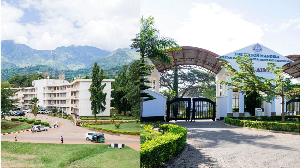CREDIBLE STATISTICS from the Judicial Service indicate a serious slowdown in the trial and delivery of justice under the Fast Track Court (FTC) system from the period within which it is deemed to dispose of cases.
Data gathered by The Chronicle suggest that the FTC is not fast after all, as there appears to be much more cases pending before the courts, which have traveled beyond the stipulated maximum period of six months since the inception of the system three years ago.
Out of 472 cases that had gone through the FTC system since its initiation on March 7, 2001, 180 (representing 38.1%) have been settled within schedule while a total of 292 (representing 61.9%) are pending.
This indicates that more than half the total number of cases had not been handled within the stipulated maximum period in accordance with the law establishing the FTC.
It also shows that some cases have taken more than a year or even two years for them to be completely settled, a situation, which seems to undermine the purpose of the FTC system.
The statistical breakdown of litigations before the FTC since its initiation is as follows: From a total number of 117 bank cases, 60 cases had been settled within schedule, whiles 57 cases are still pending and from 193 commercial cases 72 cases had been dealt with within the stipulated period, with 121 cases yet to be settled.
For revenue cases, out of a total of 10 cases, five had been completed within schedule, leaving the remaining five yet to be completed while of the 31 Investment cases 12 had gone through within the scheduled period while19 are yet to be completed.
Human rights cases total 40, out of which 17 were settled within time with 23 still outstanding; of the 30 defamation cases four were settled within schedule, whiles 26 cases are still pending and of the three industrial cases two were settled on schedule, whiles the remaining one is still pending.
Out of 10 criminal cases, four were handled within schedule whiles six are still in court; four of nine prerogative cases had been settled within schedule and of the total of 29 land cases none has been completed.
The statistics showed that 31 courts have been computerized throughout the country.
They comprise eight courts in Accra, six in Kumasi, three each in Cape Coast, Takoradi, Koforidua, and two each in Ho, Sunyani, Tamale and Tema.
The FTC system, the judicial service indicated, provided accurate records of court proceedings through a professional recording system as opposed to the normal court system, where judges were saddled with writing down all court proceedings in long hands.
Additionally parties in the adjudication of justice had daily access to proceedings from the courts, which helped them to prepare adequately for court hearings.
However, some of the cases were not disposed of as quickly as they ought to, because according to the judicial service, interlocutory applications and appeals, delayed hearings. Frequent requests for adjournments by lawyers and their clients also slowed down the hearing of cases.
Views of legal experts sampled by The Chronicle on the pace of the FTC system were mixed with some saying it had not met their expectation while others thought it was fast enough.
Those who held the view that it was not fast after all, argued that it was even slower than the normal court system.
They said unless the interlocutory applications were done away with, the problem of delays would still exist. Others suggested that the FTC should have been incorporated in the Tribunal system and that unless there were changes in the system, it would be fast only in name.
The problem of logistics also came into play and it was suggested that adequate working tools should be made available to facilitate the operations of the court.
Others who thought the system had lived up to expectation said it gave quick access to court proceedings as compared to the normal court system, which took several days.
They stressed the need for the country?s engineers to contribute their quota by manufacturing computers locally to minimize their importation so that more of the courts could be computerized to assist in the adjudication of justice.
General News of Thursday, 25 March 2004
Source: Chronicle












